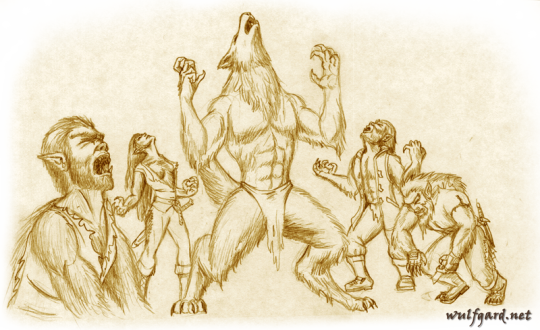Packs, Communities, and Families
I can’t believe I haven’t ever addressed this before – time for a very important werewolf fact! I touched upon it, but never covered this in detail.

What about werewolf packs? Communities? Families? What were those like in folklore? They’re so incredibly popular today – let’s talk about that a bit.
(A quick aside/reminder that wolf communication is far more complex than communication of domestic dogs and that wolves don’t bark)
The short of it is… Werewolves in folklore didn’t really do any kind of pack, community, or family thing at all. That’s a modern thing.
In folklore, just one werewolf was scary. Always. It was, in a sense, “enough.” There were essentially never groups of werewolves appearing in folklore – certainly not more than two at a time, and that alone only happened about once (looking at you, Sigmund and Sinfjotli). It was an individual with a meaningful curse.
In modern media, more often than not (especially for the last decade or so), werewolves are pretty much only dangerous in groups. They also almost always live and exist in packs. Well, that’s completely a modern pop culture thing.
And a reminder: the modern werewolf pack concept is based on inaccurate wolf pack concepts, which I covered a lot here. That doesn’t mean I don’t think it’s fun or that I dislike it. I can like it (though I think it’s way overdone lately, literally everyone has to do that and make werewolves that exist solely as pack creatures…), but I just think people should know that it isn’t accurate to real wolves in the wild and that’s not how it actually works.
Anyway!
There are a few examples in folklore of werewolves associated with wolf packs and/or that command wolf packs, but they don’t really live with them, and there are certainly no “werewolf packs” in folklore, per se. Certainly not in the modern sense. One of the closest examples we have is a werewolf leading a wolf pack in “Melion.” However, he was a werewolf stuck in wolf form at the time, which is worth mentioning.
So it was never the case in folklore that werewolves were plague rats of sorts that swept over the land like a zombie virus and were only dangerous in large groups and/or because they were infectious. As I’ve mentioned, too, the whole plague thing is also manufactured by pop culture. I talk about that a lot in this post as well.
Essentially, it goes like this: werewolves in folklore were individuals, with emphasis on their human lives and the duality of man/beast, having to live with the curse, what it stood for and how other people treated/thought of them for it. They were powerful and scary in their own right, instead of them being eternally associated with packs/groups. That was never brought up.
But modern things like to make that a centerpiece for werewolves. In modern pop culture, we see a rather overwhelming amount of werewolf media taking the “pack” route today, very often to the point of werewolves never being scary as individuals. Werewolf characters will have entire arcs based around their pack/community/family/tribe, with emphasis on them being more like wolves than people – or at least the modern concept of a wolf (the idea of a lone wolf being completely inept and incapable is a ridiculous one, and it’s even sillier to try to apply that to something like a werewolf).
To clarify, though – as I said, I don’t dislike the concept of werewolf packs. I can like them. It’s neat. I think it can be a cool idea…
But I do think that the whole werewolf pack thing has contributed a large amount to making werewolves in pop culture overall less interesting – they are so much more often not even individuals, they are less characterized, and as a whole, less powerful and scary and imposing as a werewolf. Why? Because it’s more often than not implied they need their packs to be threatening at all, and they are often characterized a great deal (or sometimes entirely) by wanting/”needing” a pack and/or caring what their pack thinks, or whatever, to the point of hardly having any personality or arcs for themselves. That, and a great deal of the uniqueness, mystery, and scariness of being a werewolf gets either totally removed or cheapened to the point of being virtually irrelevant when there are tons of other ones running around – and especially when they aren’t scary unless there are tons of other ones running around.
I could go on and on about the themes of loneliness and whatnot werewolves are often associated with (and how “werewolf packs” and “a werewolf needs a pack” can actually cheapen that a lot, too), but maybe I shouldn’t right now, huh?
Anyway, all that is unlike the folklore werewolves, who never had these kinds of issues and existed unto themselves.
Folklore also didn’t really do the whole family/inherited curse thing so much; for instance, we have Chinese legends wherein the werewolf has a family (the werewolf is often a grandma), but no one else in her family is a werewolf – and the concept of inheriting something like the curse isn’t even considered. That’s because, in folklore, it’s not a “disease” that can be “inherited/passed on.” It’s a curse that generally happened to individuals. True, it could happen to certain offspring because of specific circumstances, but it was still a curse and not something genetic or biological.
The short of it – in folklore, no, werewolves didn’t do the “werewolf pack” thing.